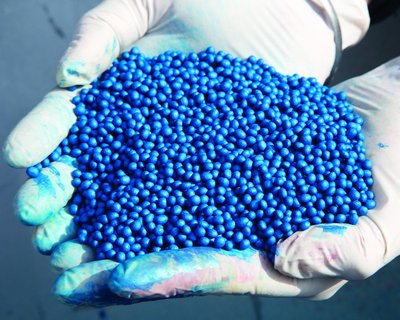Griffith seed company contains dust with equipment from Flexicon
Monday, 03 March, 2014
South Pacific Seeds (SPS) ranks as one of the world’s largest vegetable seed companies. In the 2011-2012 crop year the company produced 2930 tonnes of seeds from its facilities in Australia, New Zealand, Chile and the US. The seeds include lettuce, cauliflower, cabbage, kale, carrots, parsley, onions, cucumbers, beets and other vegetables.
Processing the seeds generated atmospheric dust at the beginning of the process, where gypsum powder is combined with a glue binder to pelletise seeds for packaging and sale. The powder is extremely free-flowing, with a bulk density of 400 g/L. Bulk bags of gypsum were cut open and emptied into a V-shaped bin feeding an auger that transported the material to a rotary treater. Here, the gypsum is mixed with the seeds and pellets are formed by the rotating action. The machine also adds colour coatings, pesticides and fungicides to the seeds.

SPS solved the dust problem at its Griffith NSW treatment plant by installing a Flexicon bulk bag discharger. Gypsum flows from the bulk bag into a floor hopper, from which the material is transported to the rotary machine by two flexible screw conveyors. The enclosed process has essentially eradicated the dust problem, says Peter Pearson, operations manager.
The Griffith plant receives gypsum powder in bulk bags of approximately 350 kg. Each bag is loaded by a forklift into the bulk bag discharger frame, where it is suspended by four loops and unloaded into a 140 L, V-shaped floor hopper. The bag is opened, the inner liner is cut and the powder is discharged through an iris valve.
Bag discharge is aided by Flexicon’s Flow-Flexer bag agitation device - two pneumatically driven plates that raise and lower opposing edges of the bag to direct material to the outlet. As the bag empties, the stroke of the plates increases, forming the bag into a V shape and promoting total evacuation.
The iris valve essentially eliminates dust, says Pearson. Nevertheless, the company also uses Flexicon’s Bag-Vac dust containment system, which is attached to the discharger frame and removes any residual dust. “The powder is particularly dusty and for operational health and safety considerations we automatically added this (dust collection) option,” he says. “As a result we have a clean and tidy working environment that is safe for the operator.”
Material is removed from the bottom of the hopper by a flexible screw conveyor. An agitator and vibrator in the bottom of the hopper help to move and direct the powder to the conveyor inlet.
The flexible screw conveyor contains a rotating, stainless steel centreless screw, housed in a durable polymer tube. It measures approximately 6 m long by 80 mm OD and is powered by a 2.2 kW, 3-phase motor that is located just beyond the discharge point, eliminating material contact with bearings or seals.
From the hopper, the conveyor moves the material at a 45° incline to one side of the rotary treater. At that point the powder is discharged through a small transition hopper into a second, identical flexible screw conveyor that carries it horizontally to an inlet cone on the side of the rotary treater.
The combination of the bulk bag discharger with the flexible screw conveyors assures that the delivery of powder to the rotary treater is consistent and uniform, says Pearson. Also, the screw conveyors solved “a big constraint, which was the amount of floor space we had to work in. The rotary machine is positioned in a tight corner and so to have a delivery system that would fit in was fantastic.” He adds that the arrangement of the conveyors provides free access for the forklift.
Seeds are received in plastic or cardboard bins of approximately 750 L capacity, or in 25 kg plastic bags. In the case of bins, the lids are removed and they are emptied by means of a special bin tipper. Bags are cut open. The seeds are cleaned up, sorted and separated by weight.
Following clean-up, the seeds are dried to less than 7% moisture content in drying bins, and then delivered to the pelletiser by a V-bin. The pelletiser mixes seeds with gypsum-based powder and a glue binder, forming pellets, which are easier to plant than single seeds. The machine can also coat the seed with a film containing colourant, fertiliser, fungicide or a pesticide, says Pearson.
Seeds are weighed and then discharged into the rotary treater, while gypsum powder is delivered by the flexible screw conveyors at a rate of 3.5 kg/min. Following the rotary treatment, seeds are dried and graded, then packaged for sale in woven polypropylene bags, plastic pails, cans and foil packages.
Milk powder: a global formula for food security
Manufacturing milk powder is an energy-intensive and costly process. As demand for...
Safer, smarter and faster: automation delivers at Coca-Cola’s Brisbane warehouse
Coca-Cola's warehouse in Brisbane needed a flexible warehouse and palletising system that...
Robotic storage system transforms NZ pharmaceuticals warehouse
New Zealand's first AutoStore has significantly improved intralogistics operations for...







